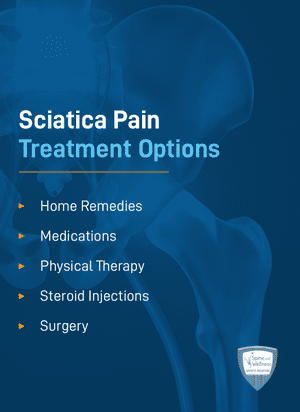Sciatica is a common, but misunderstood, type of pain. Up to 40% of inpiduals will get it in their lifetime, and the chances of you developing it increase with age. Most inpiduals with acute sciatica have a favorable prognosis, but around 20 to 30% have chronic issues after a year or two. This article teaches you more about sciatica pain, how it’s treated and if there’s a cure for it.
What Exactly Is Sciatica Pain?
Sciatica pain occurs along your sciatic nerve, which branches from your lower back to your buttocks and hips and down both legs. Generally, it affects just one side of your body. It often happens with a herniated disk, bone spur on your spine or narrowing of the spine called spinal stenosis puts pressure on part of your nerve, causing pain, inflammation and numbness in the leg affected.
What Are the Causes of Sciatica Pain?
In a majority of sciatica cases, a herniated disc with nerve root compression is the cause. However, lumbar stenosis and tumors are potential causes.
Lumbar spinal stenosis is the narrowing of the canal containing your spinal cord. As you get older, the bone may overgrow, putting pressure on your sciatic nerve. Many inpiduals with spinal stenosis suffer from sciatica on both sides of their backs.
Other possible causes are:
- Spondylolisthesis: This is a condition where you have one backbone that slips backward or forward over another backbone, potentially compressing your sciatic nerve.
- Aging: Conditions such as osteoporosis-related fractures and osteoarthritis can cause sciatica pain.
- Piriformis syndrome: This causes your piriformis muscle to trap your sciatic nerve deep in your buttock.
- A pinched sciatic nerve: Or a sciatic nerve that’s stretched.
- Pregnancy: Often women can suffer from sciatica during pregnancy.
- Carrying hard objects: This could be objects like golf balls or large wallets in your pant’s back pockets or sitting on a hard surface for a long period of time.
- Abscess, tumor or blood clot: All can result in sciatica pain.
- Severe disease: Sciatica is rarely a symptom of more severe disease.
Pain radiating from your lumbar spine to your buttock and back down your leg is a good indication of sciatica. You may experience this pain anywhere along your nerve pathway, however, it’s particularly likely to follow the path from your lower back to your buttock as well as the back of your calf and thigh.
Can You Cure Sciatica Pain?
Fortunately, sciatica is often relieved within a matter of weeks through conservative methods and without requiring surgery. Working to improve your core and back strength while enhancing flexibility throughout your lower body and hips will substantially decrease your likelihood of experiencing low back pain and other sciatica symptoms.

A physical therapist can determine if you can relieve your sciatica through conservative measures like:
- Cold therapy
- Chiropractic adjustments
- Static stretching
Most inpiduals respond well to these types of simple methods and are free of pain within a matter of weeks. Massage therapy and chiropractic adjustments might help improve your spine alignment and address any underlying conditions while also helping with muscle relaxation and blood circulation. You can treat mild pain with the application of cold and heat.
While some physicians might recommend surgery to treat sciatica if non-invasive methods fail, experts say it’s not always the best choice for everyone. Most inpiduals with sciatica will get better without surgery. Around half recover from sciatica within six weeks. While nonsurgical treatments could cause a longer recovery period, surgery has its own risks, including blood clots and infection. Therefore, you should talk about your sciatica with your doctor to decide on the best treatment approach for you.
Sciatica Pain Treatment Options
Home remedies, medication or surgery are the treatment options for sciatica pain.

1. Home Remedies for Sciatica
Sciatica pain can often limit your activities. Some home sciatica remedies you can try include:
- Don’t lift, bend or sit in a low, soft chair — your pain can get worse.
- Over-the-counter pain medications like aspirin, acetaminophen or ibuprofen can probably help alleviate your pain, unless you’re allergic or shouldn’t take them for other reasons, such as if you’re taking a blood thinner.
- A cold pack might help with the pain. If a cold pack isn’t available, a bag of frozen vegetables makes a good alternative. Or have someone use an ice cube and massage your sore spots in a triangular pattern. But, if your skin gets too cold, remove the ice cube.
- You may want to alternate with an electric heating pad after the cold massage to see if it eases the pain. But, don’t sleep with the heating pad on your back since it could cause a bad burn.
- If you can’t get an electric heating pad, you can wet a hand towel with hot water and wring it out. Then put it on your back. Some physical therapists believe the moist heat will penetrate more deeply and provide better pain relief. Don’t use wet packs together with an electric heating pad since it could result in electrical shock.
- You might feel better lying on your back on a firm surface and placing a pillow under your knees. Another thing you can do is to lie on your side and place a pillow between your knees to keep your back straight. A recliner chair might also be helpful.
- While you do want to take it easy, don’t just lie in bed since it could actually worsen your sciatica. You should engage in easy-to-tolerate activities and don’t expect to improve overnight.
If self-care measures don’t improve your pain, your doctor might recommend some of the treatments below.
2. Medications
The types of medicines that the doctor may prescribe for sciatica pain are:
- Muscle relaxants
- Anti-inflammatories
- Tricyclic antidepressants
3. Physical Therapy
Once you experience an improvement in your acute pain, a physical therapist can develop a rehabilitation plan to help you prevent injuries in the future. This generally includes exercises to strengthen the muscles that support your back, correct your posture and improve your flexibility.
4. Steroid Injections
In certain cases, the doctor may recommend a corticosteroid medication injection into the area around the nerve root involved. Corticosteroid medications help decrease pain by suppressing the inflammation around the aggravated nerve. The effects typically wear off after several months. The number of steroid injections you might receive is limited since your risk of serious side effects increases when injections occur too often.
5. Surgery
Surgery is typically reserved for when your compressed nerve leads to:
- Loss of bladder or bowel control
- Significant weakness
- Your pain isn’t improving with other therapies or progressively worsens
Surgeons can remove the part of your herniated disk pressing on your pinched nerve or remove the bone spur.
At-Home Exercises to Treat Sciatica Pain
Once your pain goes away, you can get moving to prevent recurring attacks.
Many inpiduals fear activity is what causes their pain. However, low-impact exercise and activity can actually help to strengthen the area, preventing future attacks. Exercises may include:
- Riding a stationary bike
- Water aerobics
- Yoga
- Daily back stretching
A physical therapist or doctor might recommend you perform a few of these stretches below daily:
1. Reclining Pigeon Pose
Pigeon pose a popular pose in yoga that opens your hips. There are three variations of this pose.
The starting version is called reclining pigeon pose. If you’re just beginning your treatment, this is the pose you’ll want to do first.
- Lie on your back and bring your right leg up so your calf is parallel to the floor and your knee makes a 90-degree angle. Clasp your hands behind your thigh. Lock your fingers.
- Now, place your left ankle on your right knee.
- Hold this pose for a minute. It helps stretch your piriformis muscle, which can occasionally become inflamed and press against your sciatic nerve, leading to pain.
- Switch sides.
- Once you can perform this pose without pain, your physical therapist will likely transition you to sitting pigeon pose then forward pigeon pose.
2. Sitting Pigeon Pose
The next version is sitting pigeon pose.
- Sit on the floor and stretch your legs straight out in front of you.
- Place your right ankle on your left knee so your lower leg is parallel to the floor and your right knee points to the right, not up.
- Lean forward, reaching your upper body toward your thighs.
- Hold this pose for up to 30 seconds to stretch your lower back and glutes.
- Switch sides.
3. Forward Pigeon Pose
The third version is forward pigeon pose. This pose is similar to sitting pigeon pose except your straight leg stretches behind you instead of in front.
- Get on your hands and knees on the floor.
- Bring your right knee between your two hands. Twist your leg so your knee points to the right and your foot is in front of your left hand. Rest your leg on the floor.
- Stretch your left leg behind you, resting the top of your foot on the floor.
- Gradually shift your weight from your arms to your legs. Using your hands for support, sit up straight.
- Breathe deeply. On the exhale, lean forward over the leg in front. Support your weight with your hands as needed.
- Switch sides.
4. Knees to Chest
This simple pose can stretch your glutes and lower back.
- Lie on your back flat with the soles of your feet on the floor and knees bent.
- Slowly start hugging your knees into your chest.
- Hold for 30 seconds, for best results, before you release the stretch. Repeat the stretch a few more times if possible.
5. Cobra or Modified Cobra
Cobra pose is a slight backbend to reset after stretching your lower back.
- Lie on your tummy, extend legs together and bend your elbows so your palms rest on the floor by your chest.
- For modified cobra pose, push through your palms and straighten your elbows partially to lift your chest off the floor around 45 degrees.
- For full cobra pose, straighten your elbows fully and lift your chest even further off the floor.
- In either position, hold for five seconds at the top, then return to the starting position. Aim to repeat this stretch 10 times.

6. Knee to Opposite Shoulder
This stretch helps loosen your piriformis and gluteal muscles.
- Lie on your back, extend your legs and flex your feet upward.
- Bending your right leg, take your hands and clasp them around your knee.
- Pull your right leg gently over your body toward the left shoulder and hold for 30 seconds. Only pull your knee as far as you can comfortably. The stretch should feel relieving, not painful.
- Pushing your knee, return your leg to its beginning position.
- Aim to repeat this exercise for three times and then switch sides.
7. Standing Hamstring Stretch
This pose could help alleviate tightness and pain in your hamstring that sciatica causes.
- Put your right foot on a raised surface at or below hip level. You can use an ottoman, chair or stair. Now, point your toes until your leg and toes are straight. If you tend to hyperextend your knee, bend it slightly.
- Lean forward toward your right foot. The more you bend, the deeper stretch you’ll get. Don’t push to the point it causes pain.
- Let your right hip release downward rather than lifting it. If you have a hard time getting your hip down, you can loop an exercise band or yoga strap underneath your left foot and over your right thigh.
- Hold for 30 seconds, then switch sides.
Don’t assume you’ll be as flexible as each exercise calls for. You need to work your way up to this type of flexibility. People in videos on TV or the internet can get into these stretches and poses more easily because they are generally more flexible and have been performing the exercise for years. If you experience any pain, you should immediately stop.
There’s no one-size-fits-all stretch or exercise for all inpiduals with sciatic nerve pain. You should adjust the positions slightly like bringing your knees in less or more and see how you feel. If one position feels better, that’s the one you want to pursue.
If you experience even minor sciatic nerve pain for over a month, you should see your doctor or a physical therapist. They might set you up with a customized exercise program you can do at home that’s specifically for your pain.
Contact NJ Spine and Wellness for Your Sciatica Pain Relief

The licensed professionals and highly-trained staff here at NJ Spine and Wellness include specialists in physical therapy, chiropractic care, acupuncture, sports medicine, pain management, neuro rehab and regenerative medicine, occupational therapy and nutrition. We are here and ready to provide you and your family total wellness and help you get better faster. Book your appointment today.

